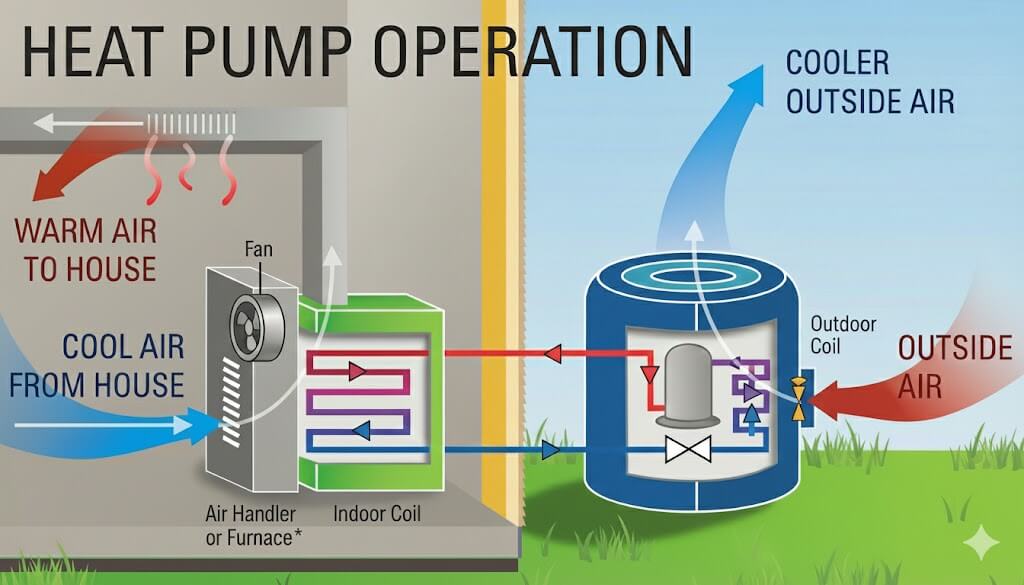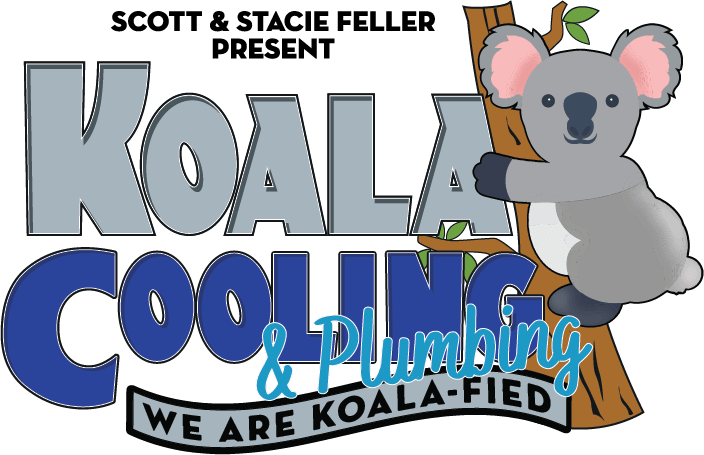A heat pump is one of the most versatile comfort systems available for homes today. It can heat your home in the winter and cool it in the summer, all while using much less energy than most traditional systems. Instead of burning fuel or using electric resistance to create heat, a heat pump transfers it from one place to another. That simple difference is what makes it so efficient.
Across Central Texas, more homeowners are choosing heat pumps because our moderate winters and warm summers are ideal for their performance range. They’re especially appealing for those who want to lower energy use without giving up comfort. With one system handling both heating and cooling, maintenance and operating costs can also be easier to manage.

The Basics of Heat Pump Operation
At its core, a heat pump moves heat rather than creating it. It works through a closed system of refrigerant that compresses, expands, and circulates to absorb and release heat.
In the cooling season, the system extracts heat from inside your home and releases it outdoors. During the heating season, it reverses the process—pulling heat energy from the air outside and transferring it indoors. Even when temperatures drop, there’s enough heat energy in the air for the refrigerant to capture and move.
This process follows a simple rule of physics: heat naturally moves from warmer to cooler areas. A heat pump uses a small amount of energy to reverse that flow when needed, delivering comfort efficiently. Compared to a furnace that burns gas or an electric heater that generates heat directly, a heat pump can often provide the same comfort while using about one-third of the energy.
Main Components of a Heat Pump System
While a heat pump looks a lot like a traditional air conditioner from the outside, it has a few parts that make it different:
- Outdoor unit: Contains the compressor, fan, and a coil that either absorbs or releases heat depending on the mode.
- Indoor air handler: Houses another coil and a blower fan that circulates conditioned air through the ducts.
- Refrigerant lines: Copper tubing that carries refrigerant between the indoor and outdoor coils.
- Reversing valve: The component that allows the system to switch between heating and cooling.
- Thermostat and controls: Manage operation and coordinate communication between components for consistent comfort.
When installed and maintained correctly, these components work together to provide balanced indoor temperatures all year long.
How It Works in Cooling Mode
When you set your thermostat to cool, your heat pump operates much like a standard air conditioner:
- Warm indoor air passes over the indoor coil, where refrigerant absorbs the heat.
- The refrigerant carries that heat to the outdoor unit.
- The outdoor coil releases the heat into the air outside.
- The refrigerant cools down and cycles back indoors.
- The blower fan pushes the cooled air through your ducts and into your living spaces.
Because the system removes heat rather than generating cold air, it achieves cooling with less energy use. This continuous cycle keeps your home comfortable through Austin’s long, hot summers. Many modern heat pumps also include variable-speed fans and compressors to fine-tune performance and control humidity.
How It Works in Heating Mode
When temperatures drop, the heat pump reverses direction. The reversing valve changes the refrigerant flow, and the system starts extracting heat from the outdoor air:
- The outdoor coil absorbs heat energy from the air.
- The refrigerant carries that heat inside.
- The indoor coil releases the heat, and the blower distributes warm air throughout your home.
Even on cold mornings, outdoor air contains usable heat energy. Modern systems use advanced compressors and refrigerants that let them perform efficiently in temperatures well below freezing. That’s rare for Central Texas, but it means your home stays warm with steady, gentle heat that doesn’t dry out the air like some furnaces do.
Types of Heat Pumps
There are several types of heat pumps used in homes today, each suited to different needs:
- Air-source heat pumps: The most common type, using outdoor air for heat exchange. They’re efficient, affordable, and well-suited for Central Texas.
- Ground-source (geothermal) heat pumps: Transfer heat through buried loops in the ground, where temperatures stay stable year-round. They’re extremely efficient but have higher installation costs.
- Ductless mini-split systems: Operate without ductwork and are perfect for home additions, older houses, or areas needing independent temperature control. Each indoor unit heats or cools a specific room or zone.
Each type has unique advantages, but all use the same heat transfer principle. The best choice depends on your home’s layout, your energy goals, and your comfort needs.
Performance and Efficiency Factors
A heat pump’s performance depends on several key factors:
- Outdoor temperature: Efficiency decreases as temperatures drop, though new technology continues to improve cold-weather performance.
- Maintenance: Clean coils, proper refrigerant levels, and good airflow keep your system efficient. Regular tune-ups are essential.
- Sizing and installation: A system that’s too large or too small will cycle improperly and waste energy. Professional installation ensures correct sizing, airflow, and refrigerant balance.
Efficiency ratings help homeowners compare systems. SEER2 measures cooling efficiency, while HSPF2 measures heating efficiency. Higher numbers mean better performance and potential savings on energy bills. Proper setup and annual maintenance help ensure your system performs as rated.
What’s Next?
If you’re considering a heat pump or want to know whether it’s the right fit for your home, we can help! We’ll guide you through your options, explain what works best for your home, and make sure your installation is done right. With the proper setup, you’ll enjoy dependable comfort and long-term savings for years to come. Contact us for more information.
